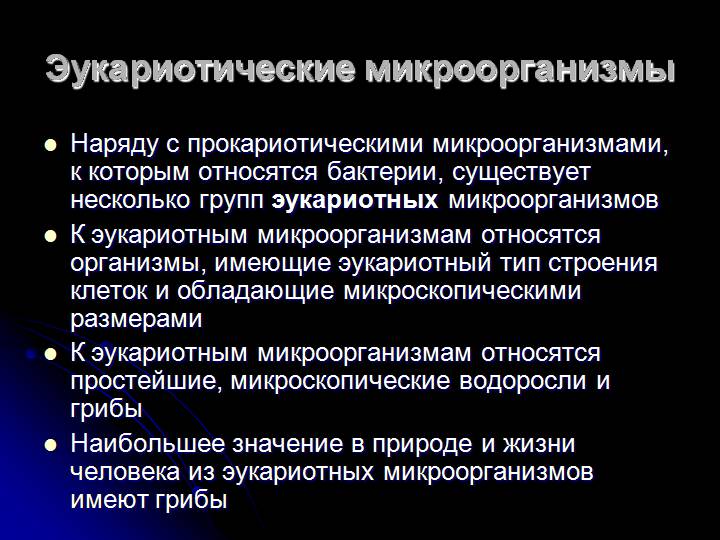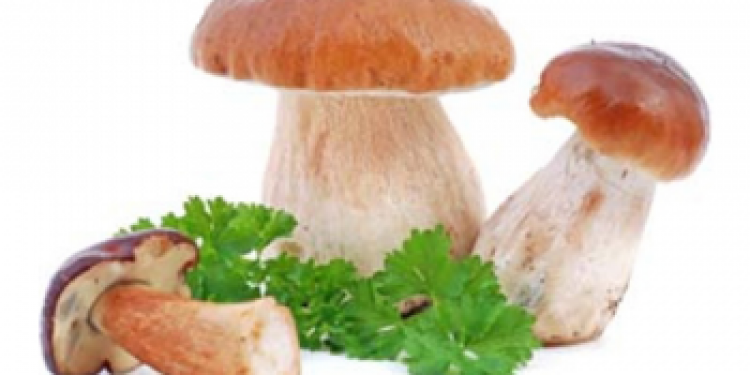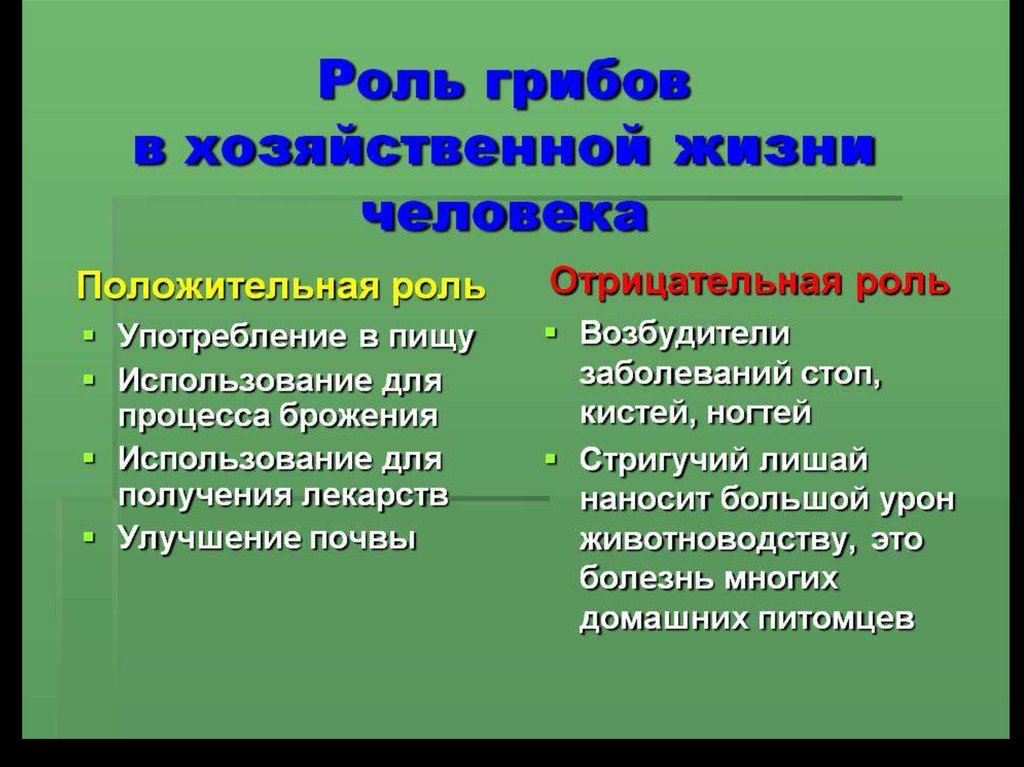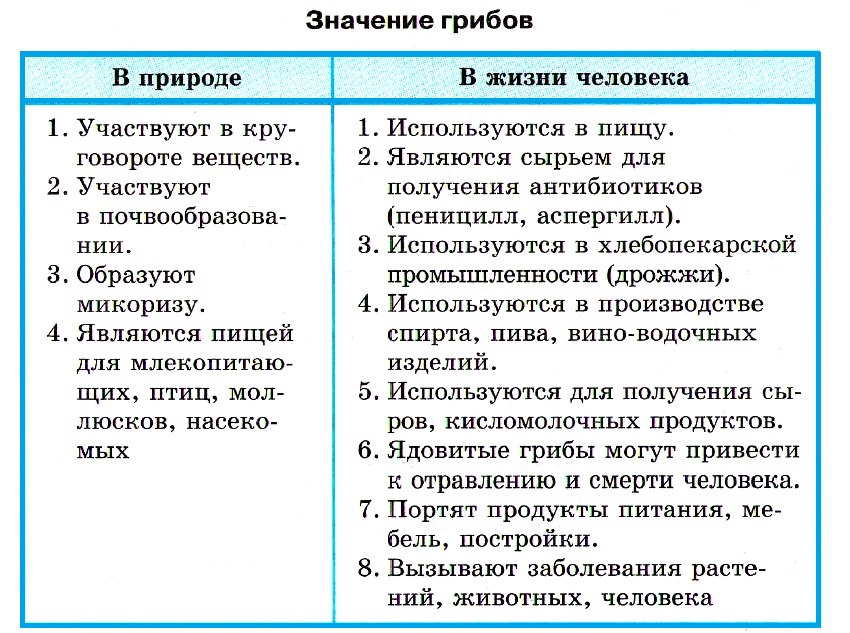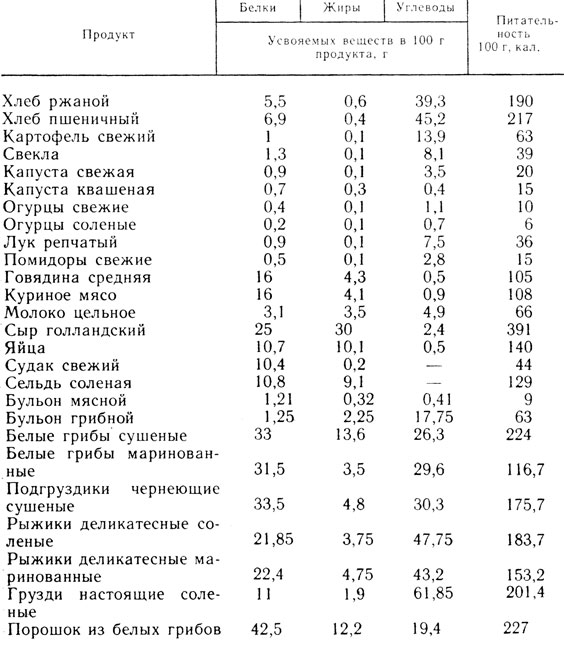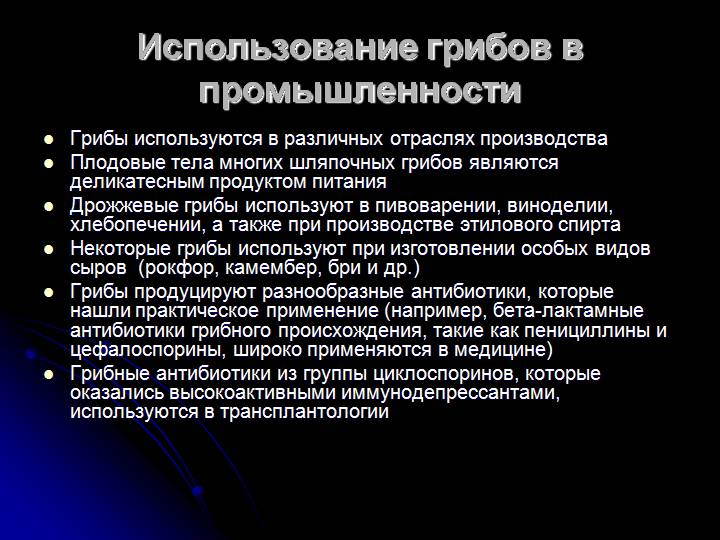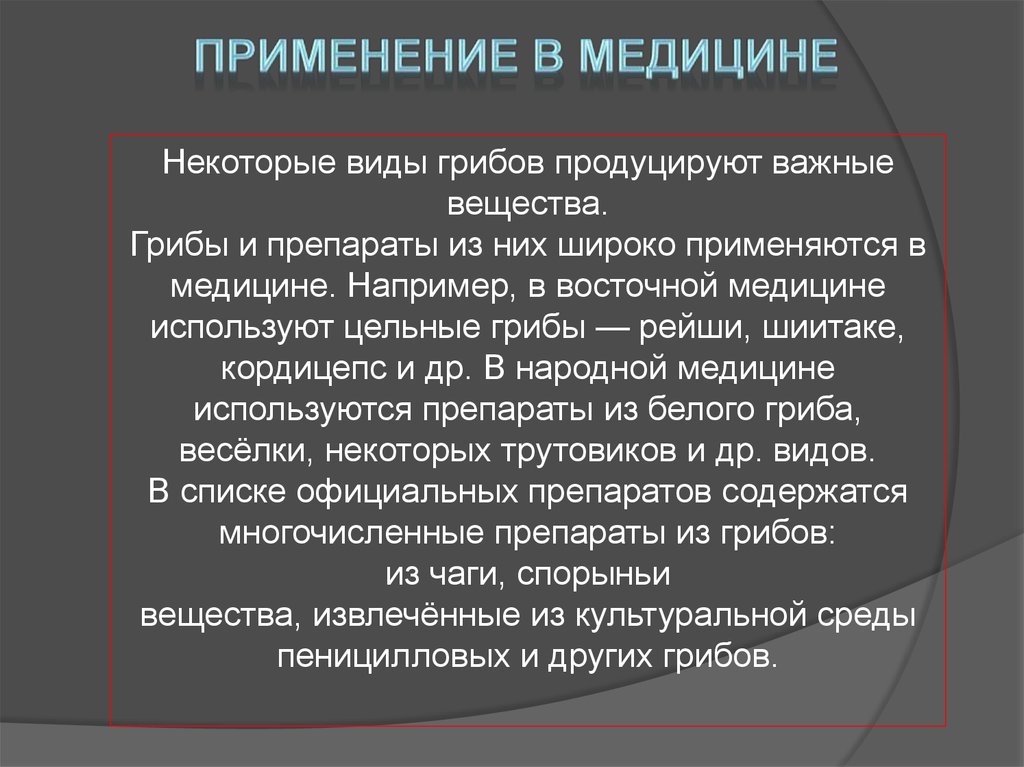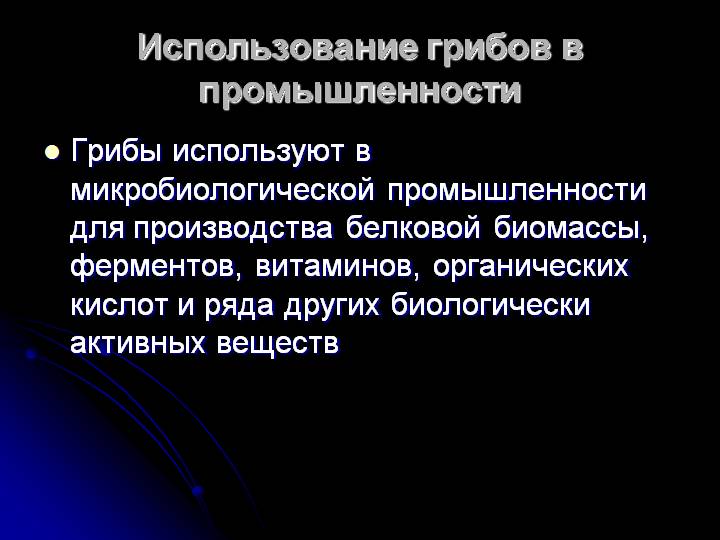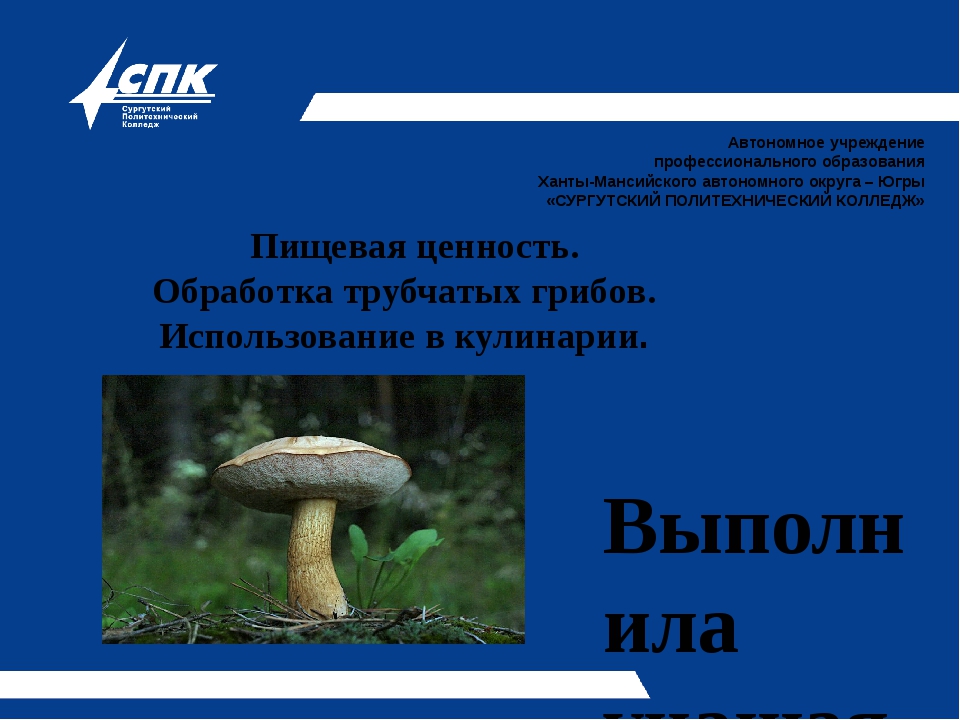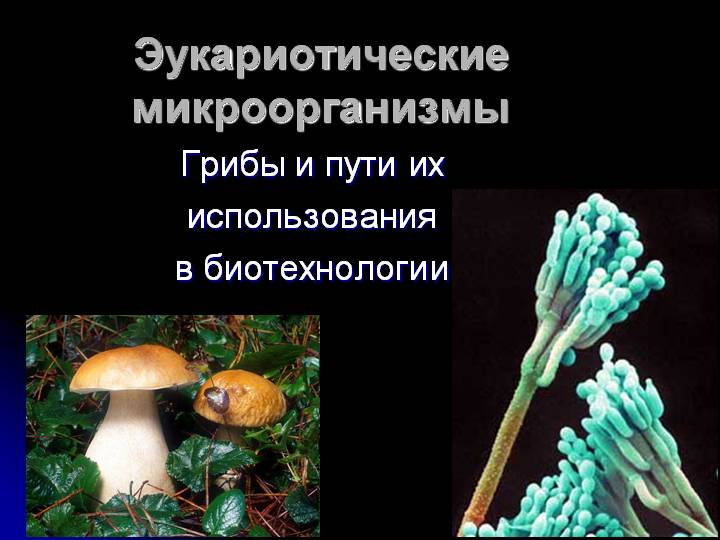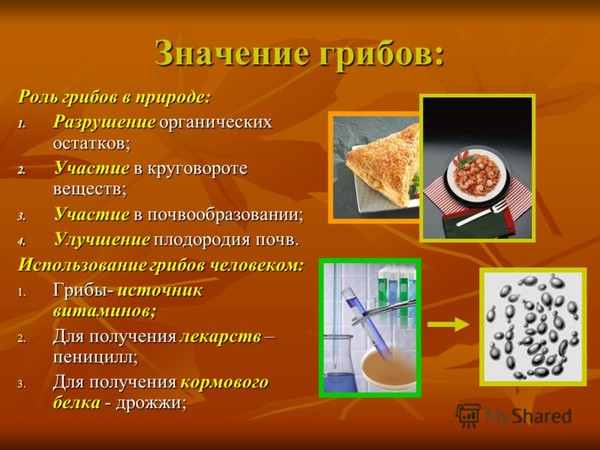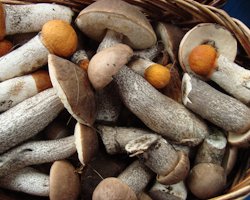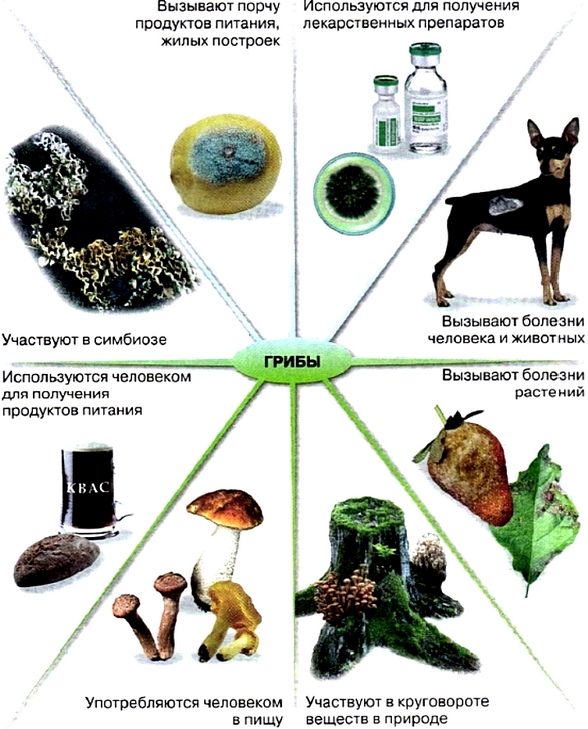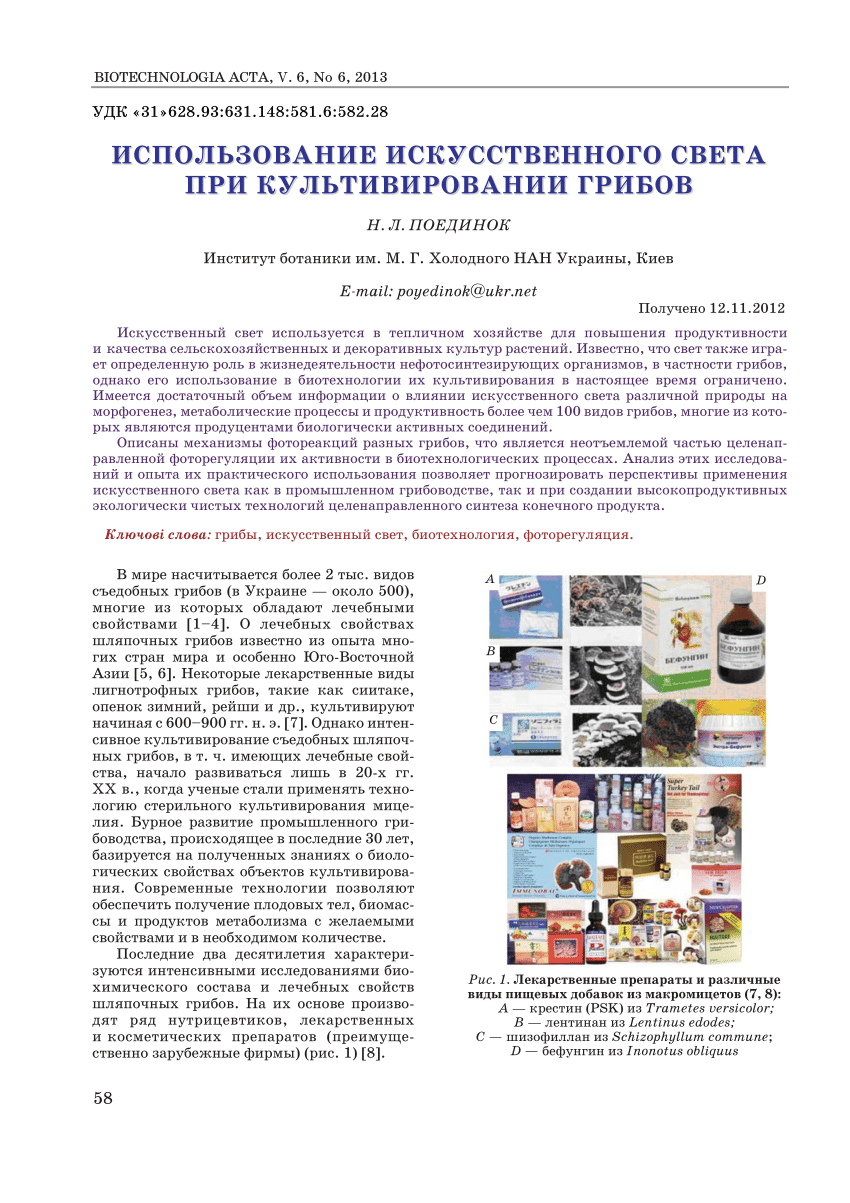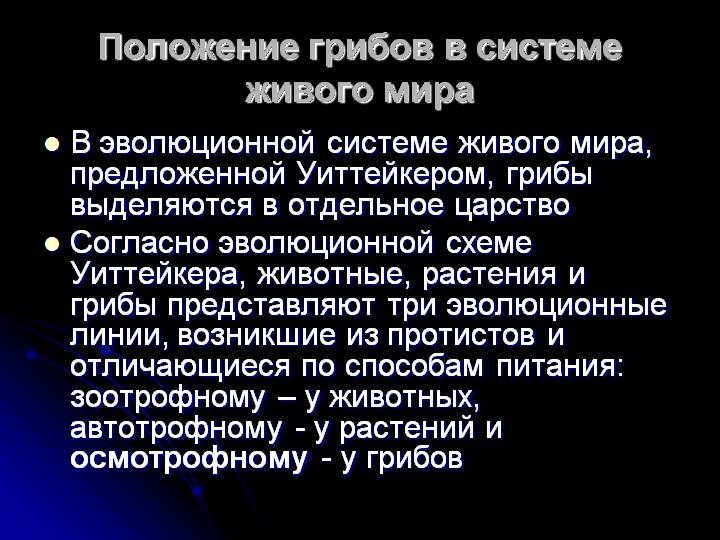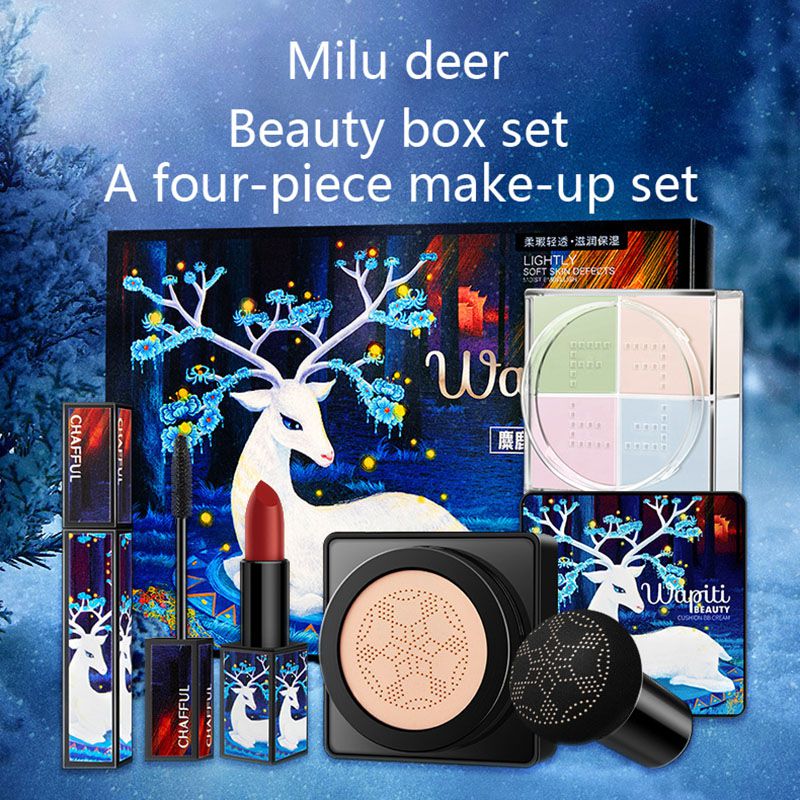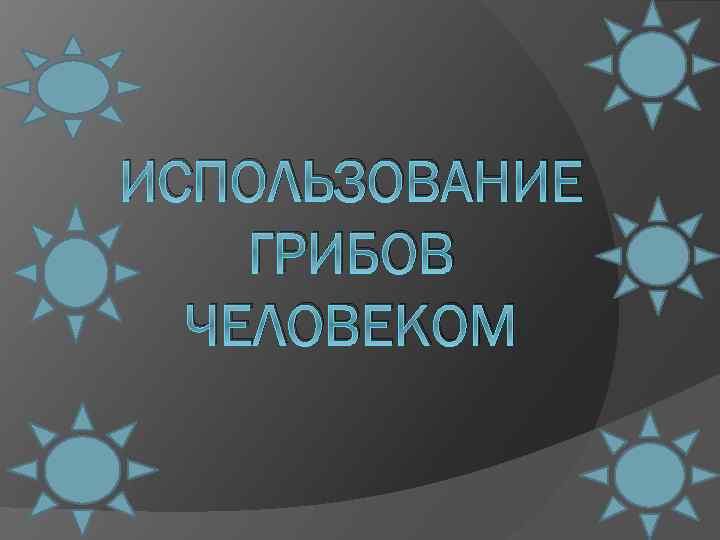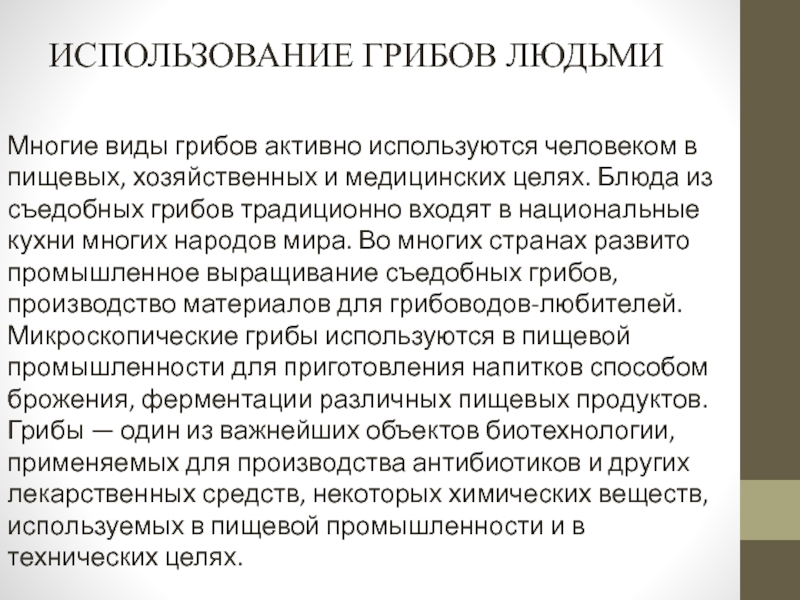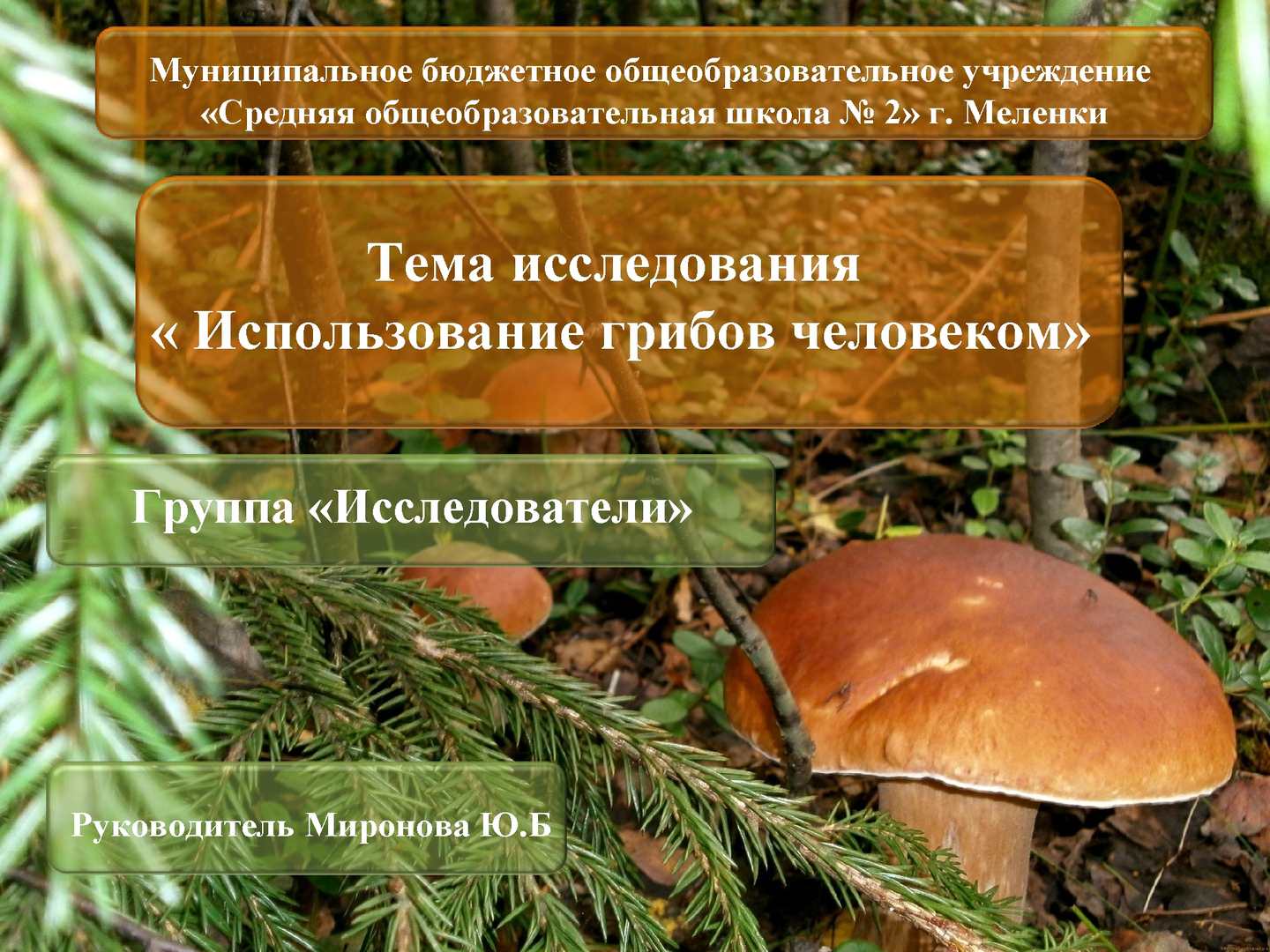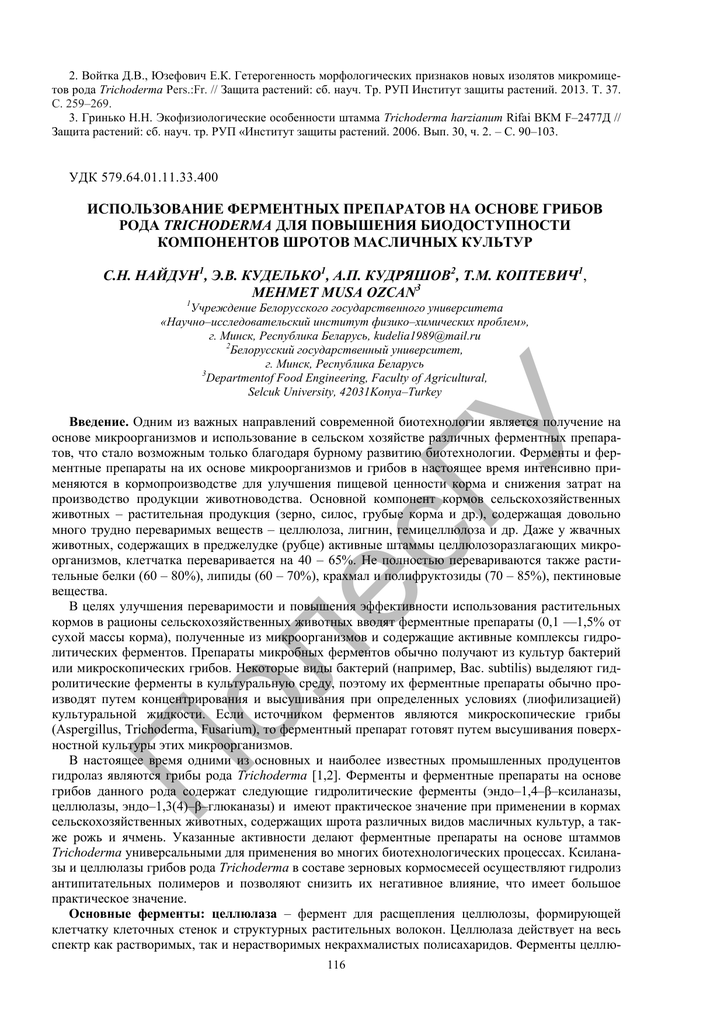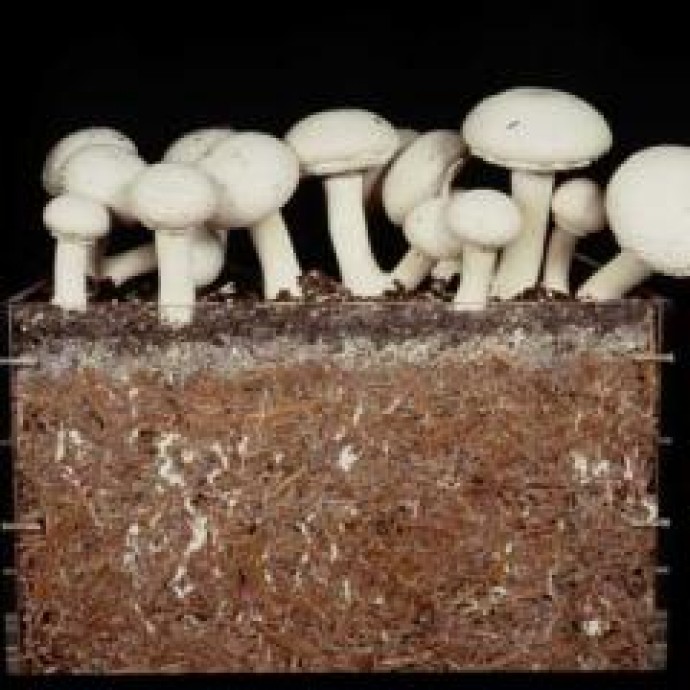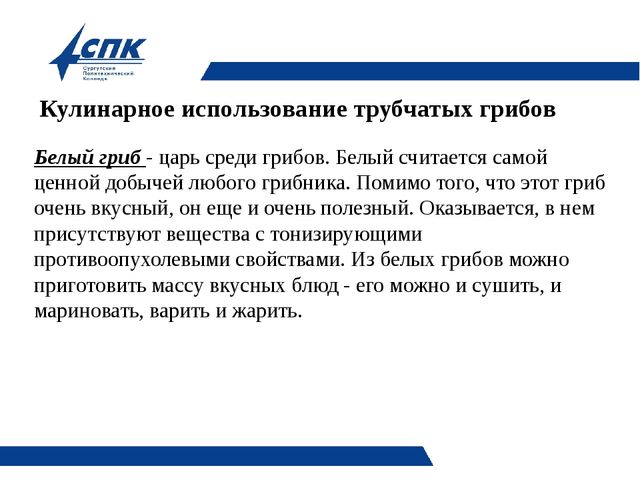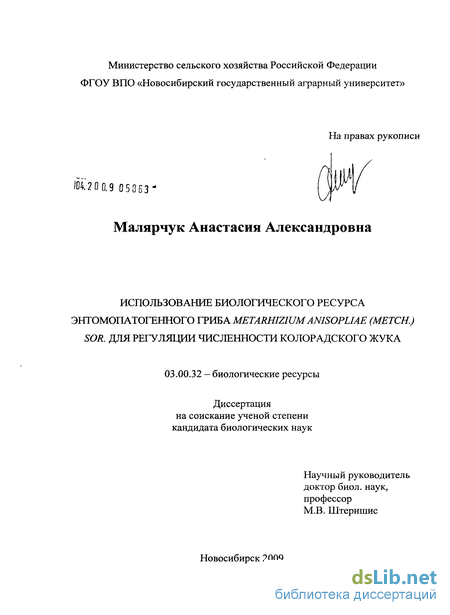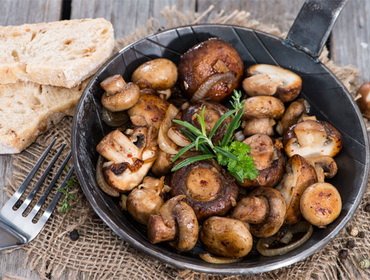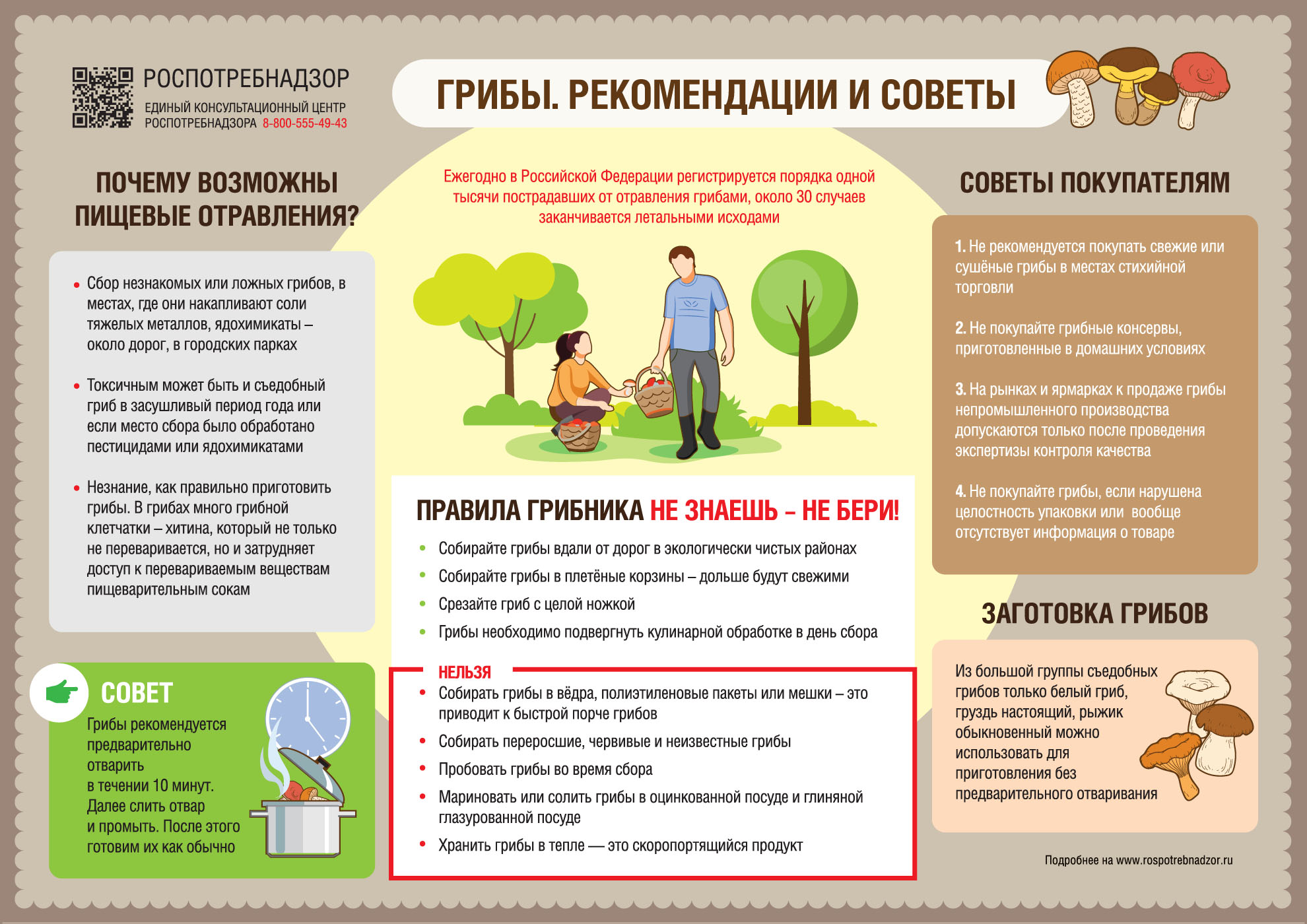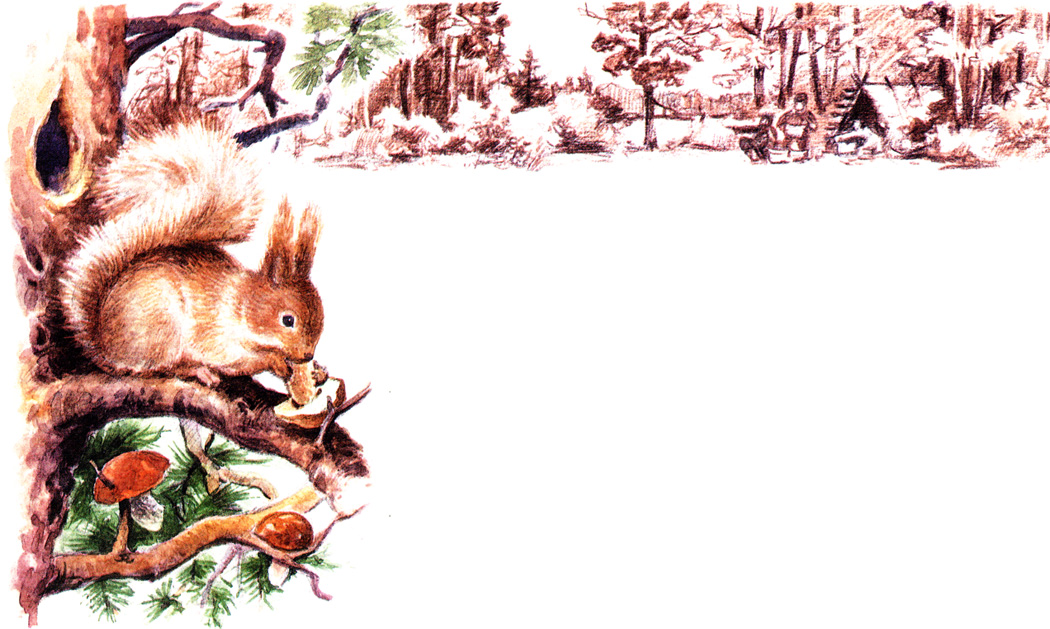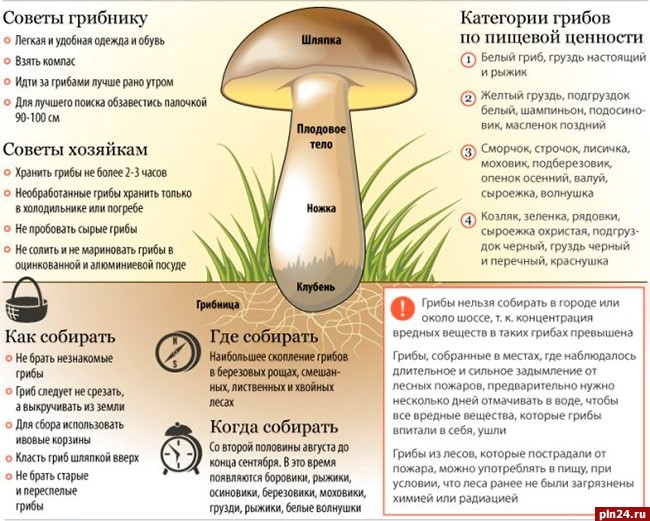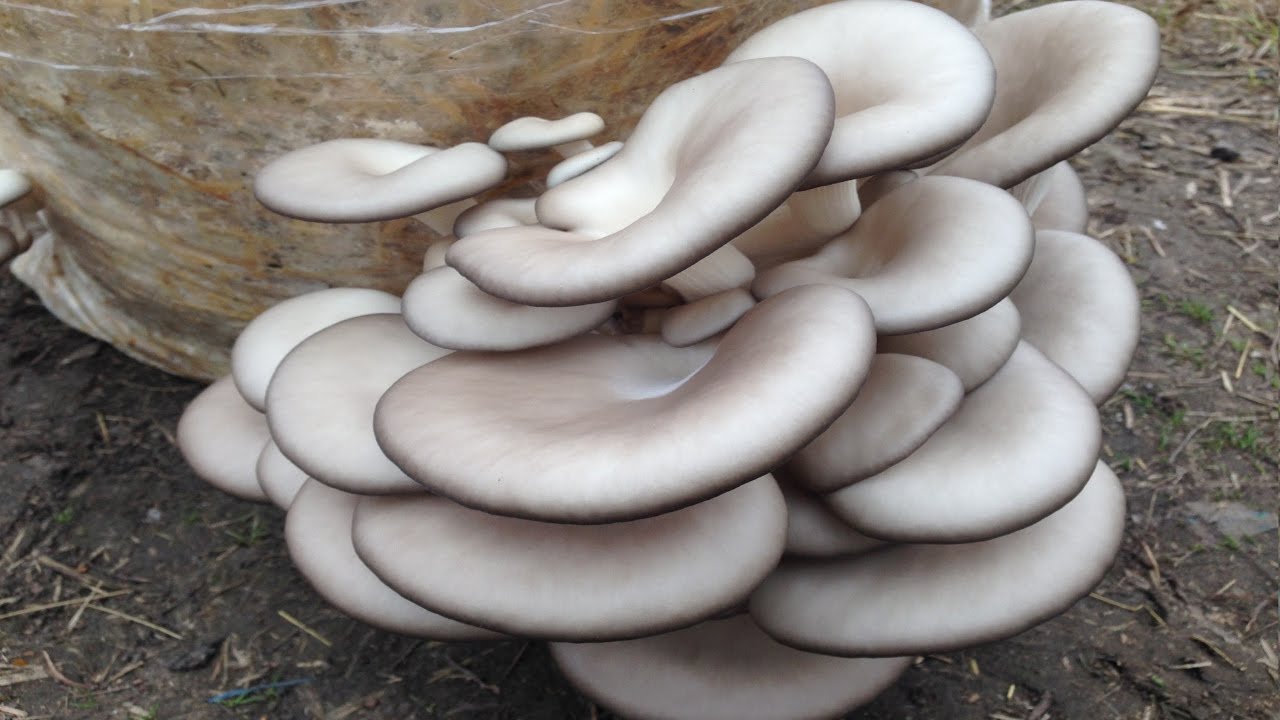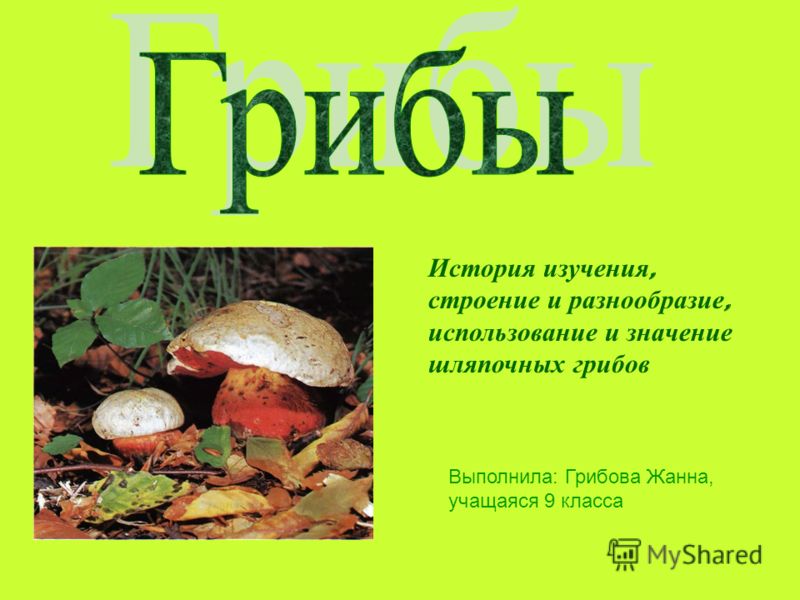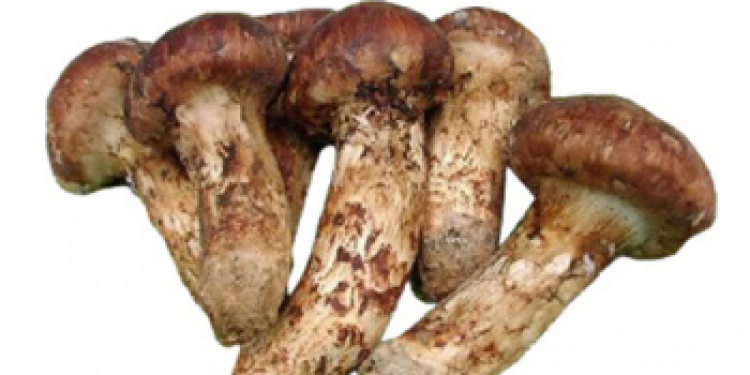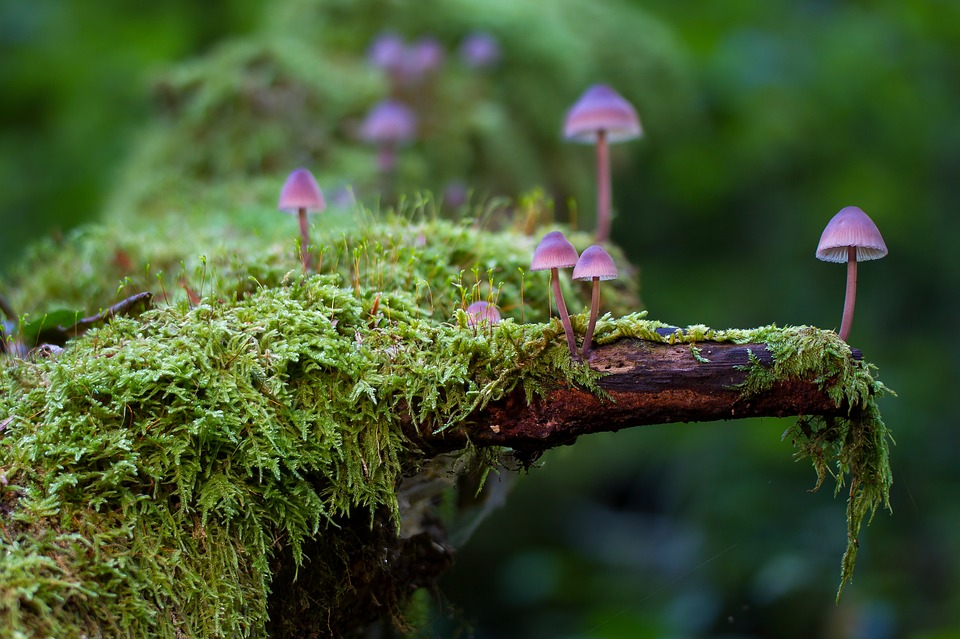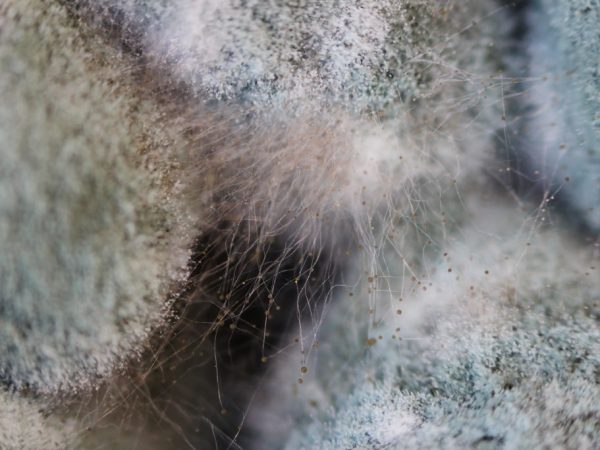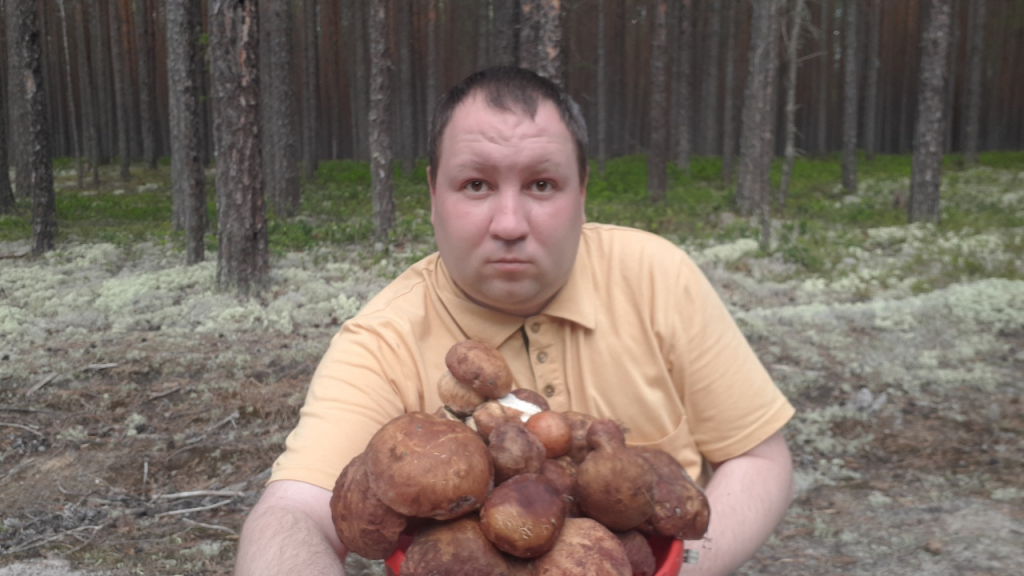Useful properties of mushrooms
Fresh mushrooms contain up to 95% water. Of the compounds, 70% is protein, of carbohydrates, in addition to glucose, the sugar trehalose and the sugar alcohol mannitol are contained. Instead of fiber shell mushrooms consist of fungin. Minerals make up 1% of the weight; these are salts of potassium, phosphorus, iron, sulfur and chlorine.
Mushrooms contain 18 types of amino acids, a number of vitamins B1, B2, B, PP, C, D, E. All this favorably affects our body.
Young mushrooms are most valued; there are more nutrients in the cap than in the stem. It is not recommended to collect old mushrooms, they are poorly digested and you can get an upset stomach or worse, poisoning. In old mushrooms, the process of protein breakdown is underway.
In the previous article, we said that mushrooms are perishable and therefore need to be processed on the day of harvest. Cooked mushroom dishes cannot be stored for a long time, even in the refrigerator, cook the amount that would be eaten at one time.
When frying and boiling mushrooms, a significant part of the nutrients is destroyed; in salted and dried mushrooms, much more of them remains. When dried, almost all the protein is retained, so dried mushrooms are very useful and nutritious.
It is recommended to include mushrooms in your diet no more than 4 times a week.
If you follow the above recommendations, mushrooms will become a wonderful and useful part of your diet.
- A set of useful compounds in mushrooms helps to normalize metabolism.
- They have a beneficial effect on the nervous system.
- They improve the processes of blood formation and strengthen blood vessels, which have a beneficial effect on the cardiovascular system.
- They have a beneficial effect on the condition of hair, nails, teeth and skin, and are a natural elixir of youth.
- Regulate blood pressure.
- Remove harmful cholesterol from the blood.
- Participate in the production of hormones by the pituitary gland.
- Beta glucans support the immune system and have a high anti-cancer effect. This effect is also achieved thanks to melanin, one of the most powerful natural antioxidants.
- Eating mushrooms prevents anxiety and stress, has a beneficial effect on the functioning of the brain, significantly reduces mental exhaustion and feelings of irritation and anxiety.
Watch a video about the benefits of mushrooms:
Research on fungi based on traditional medicine [edit | edit code]
Many mushrooms are currently used as medicinal, they are used in the form of food, dietary supplements, tinctures, extracts, etc. One of the most important areas of research at the present time is to determine the possibility of using drugs from natural raw materials as drugs for cancer.
Some of the mushrooms are very well known.
Medicinal properties of mushrooms
Each mushroom is somewhat different from the others in chemical composition. By eating different mushrooms, you can achieve powerful positive effects on the body.
White mushroom is considered the most useful and valuable. It contains an antibiotic that destroys the tubercle bacillus; herzenin, which reduces pain in angina pectoris; effective anticancer agents. It contains a lot of riboflavin, which normalizes the function of the thyroid gland, hair, nails, skin and the health of the body as a whole. Boletus extract is used for frostbite of the extremities.
Oyselka and shiitake mushrooms are effective in the treatment of cancer.
Oyster mushrooms help cleanse the blood of cholesterol and toxic substances, normalize the composition of the intestinal microflora.
Champignons are rich in thiamine, which helps with migraines. They are rich in vitamins, iron, phosphorus, potassium and zinc.
They are useful for headaches and gout.
Pepper milk mushrooms contribute to the dissolution of urinary stones, have a diuretic effect.
Gingerbread is rich in vitamin A, synthesizes an antibiotic that slows down the growth of pathogenic microorganisms.
The talker produces a substance that is effective in the treatment of tuberculosis of the bone and skin forms.
Meadow honeydew is useful for normalizing the amount of Escherichia coli, destroying staphylococci and other pathogenic microflora.
Chanterelles, ground into powder, have an anthelmintic effect. Infusion of chanterelles treat sore throat and skin abscesses.
Biologically active substances in the composition of mushrooms
It has been scientifically proven that some types of fungi have the following effects on the body:
- antioxidant;
- antidiabetic;
- immunomodulatory;
- antimicrobial.
Numerous scientific studies confirm that some types of fungi have anti-tumor effects.
Mushrooms against cancer
This has been proven by experts from Tufts University (USA).
In the course of the study, scientists found that due to the substances contained in these mushrooms, their use has a beneficial effect on dendritic cells, which are produced by the immune system to fight against malignant tumors. This group of cells is responsible for the production of white blood cells (T-lymphocytes), which prevent cancer cells from overcoming immune defenses.
Experts recommend regularly including these mushrooms in the diet, as they have a significant anti-cancer effect and are effective in preventing cancer.
Chanterelle mushrooms have a similar antitumor effect on the body.
This effect is due to the presence of a substance called "polyosellin" in the composition of this fungus. This component has anti-cancer activity.
In Japan, a study was conducted on the anti-cancer properties of the mushroom mushroom.
Doctors extracted polysaccharides from the mushroom and injected them into the body of mice. As a result, these polysaccharides have been shown to inhibit the growth of sarcoma.
Borovik (porcini mushroom)
There is an opinion that the regular inclusion of porcini mushrooms in the diet can reduce the risk of developing malignant neoplasms, but this has not yet been confirmed. But in boletus, substances were found that suppress the activity of some types of pathogenic intestinal microflora and help improve digestion. The alkaloid herzenine contained in these mushrooms relieves the condition of patients with angina pectoris. Traditional medicine uses boletus to treat tuberculosis and metabolic disorders. Such drugs also help with anemia and loss of strength. External use of porcini mushroom extract is indicated for non-healing ulcers and frostbite.
Regular intake of tincture of boletus caps helps to reduce blood viscosity, which is very important for patients with arterial hypertension and angina pectoris. In addition, the agent is used to treat benign neoplasms of the female genital area (fibroids, cysts, etc.
etc.).
To prepare the medicine, the caps of the porcini mushrooms are crushed, poured into a liter jar “up to the shoulders” and poured with vodka, infused for two weeks in a dark place, then the raw materials are squeezed out, and the liquid is filtered. The medicine is taken twice a day 30 minutes before meals, diluting a teaspoon of the drug in 50 ml of water.
Scientific interest
Yeast is a subject of study for researchers around the world, and there are thousands of scientific articles today.
This interest stems from the fact that this single-celled fungus is a rapidly growing organism in a bulb and whose DNA can be easily manipulated while providing insight into basic human biological processes, including disease.
In addition, since they are unicellular organisms, they are easy to study and have a cellular organization similar to that of higher and multicellular organisms such as humans, that is, they have a nucleus and are therefore eukaryotes ..
This similarity in cellular organization between yeast and higher eukaryotes leads to similarities in their fundamental cellular processes, so that discoveries made in yeast often provide direct or indirect clues about how biological processes work in humans.
On the other hand, unicellular fungi reproduce rapidly and are easily genetically manipulated. There are also well-defined genetic methods and maps for yeast that gave researchers the first insight into the genome and its organization, and they were the culmination of genetic research starting in the first half of the 20th century.
In fact, due to the fact that the yeast gene is similar in DNA sequence to the human gene, the information that scientists obtained from their research has provided powerful clues about the role of these genes in humans.
The role of mushrooms in human life: food
Since ancient times, people have been consuming mushrooms as food. Edible in nature - more than 100 species, but is actively used for the needs of the culinary arts of all countries and peoples - up to forty. As you know, these creatures contain enough nutrients. They also contain a lot of proteins (by the way, in many types of religious fasts, they are allowed to be consumed at this time, along with plants). And people living near forests or in the taiga have long valued mushrooms as one of the main and inexhaustible sources of protein food. In pre-revolutionary times (and at the present time) for the inhabitants of the village it was a good help in feeding the family.
Why porcini mushrooms are useful for humans and what is included in their composition
White mushroom has a complex chemical composition and associated healing properties. The fruit body of this mushroom contains: proteins, fats, polyunsaturated fatty acids, dietary fiber, carbohydrates, vitamins (D, C, B1, B2, B6, B9, E, PP and carotene), mineral salts (potassium, sodium, calcium, iron , phosphorus, magnesium, silicon, sulfur, fluorine, zinc and some other elements), antibiotics, antioxidants, lecithin. In addition, boletus contains mushroom polysaccharides and other biologically active substances.
Also, the benefits of porcini mushrooms for the body are due to the hercedine alkaloid included in their composition, which relieves pain in angina pectoris, increases the body's immunity and resistance to various infections, is a good prophylactic agent against angina pectoris and cancer.

Boletus has anesthetic, anti-inflammatory, bactericidal, wound healing, antiviral, antifungal, tonic, tonic and antitumor effect. Also, the useful properties of porcini mushrooms include the ability to expand blood vessels, reduce the rate of blood clotting and blood pressure, thin blood, cleanse blood vessels from cholesterol plaques, relieve pain in angina pectoris, restore impaired metabolism, remove various harmful substances from the body, including heavy metal salts and carcinogens.
Porcini mushrooms are used to treat angina pectoris, hypertension, atherosclerosis and other diseases of the cardiovascular system, headache, intestinal infections, pulmonary tuberculosis, general weakening of the body, impotence, varicose veins and thrombophlebitis, is a good way to prevent the development of heart attacks and strokes. White mushroom is a good remedy for the prevention of malignant neoplasms.
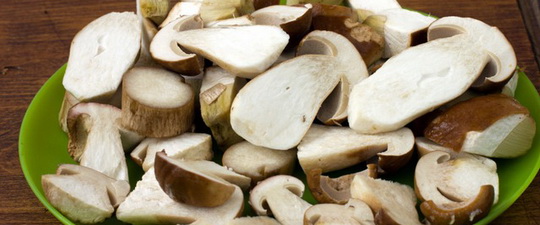
Boletus regulates the metabolism and work of the digestive organs, recovers strength after heavy operations and diseases, with physical and mental fatigue, helps with sexual disorders associated with weakening of orgasm, prevents the development of many diseases of the digestive system, as well as various forms of cancer.
Also, the medicinal properties of porcini mushrooms are used in the treatment of benign tumors of the female genital organs (fibroids, fibroids, cysts, etc.).
Aqueous extract of porcini mushroom is also used externally for the treatment of various skin diseases (burns, frostbite, ulcers, wounds, etc.), as well as for facial skin care (it makes the skin clean, velvety, smoothes wrinkles).
Boiled mushrooms are applied to bruises.
The benefits of dried porcini mushrooms are especially high. For the treatment and prevention of the aforementioned diseases (including cancer), it is better to use powder from these mushrooms, which can be added to ready-made dishes: salads, snacks, omelets, sandwiches and many others.
The calorie content of porcini mushrooms is about 30 kcal per 100 g of fresh product.
Contraindications for the use of porcini mushrooms: acute diseases of the stomach, intestines and liver. It is also not recommended to give mushrooms to children under 7 years of age, as well as to patients suffering from gout.
Chaga
Chaga (black birch mushroom), like the previous species, also belongs to tinder fungus, only it is much more common in our territory. Surely everyone has seen on the trunks of deciduous trees (most often birches) not very pretty dark lumpy growths of irregular shape - this is chaga.
In folk medicine of Russia, drinks, tinctures and decoctions based on chaga were traditionally used both as a drink (kvass and tea with its addition were popular) and as a means for bathing.
The healing properties of chaga are also based on the action of biologically active substances, "at the head" of which are all the same useful polysaccharides, from which active antineoplastic agents are isolated, as well as organic acids and some other compounds. Due to their presence, preparations from chaga act as a general tonic, increase the body's defenses, and help regulate metabolic processes. If we talk about narrower things, then chaga is used as an antitumor (including in the case of malignant tumors), anti-gastritis and antiulcer agent - primarily as a symptomatic pain reliever and improving overall well-being.
On sale you can find ready-made powdered dried chaga for infusion, as well as its water-soluble extracts for quick intake after dissolving in warm water. On the basis of chaga, the general tonic and analgesic drug Befungin, recommended for chronic gastrointestinal diseases, was also created.
For independent use of chaga for medicinal purposes, you can collect its fruiting bodies at any time of the year. The most dense inner part of the fruit body (pulp) is used as raw material, cleaned of wood residues and outer rind and ground into powder, which is then, as needed, infused with water or alcohol (the shelf life of dry raw materials is two years).
With nervous disorders, you can take a course of baths with chaga and medicinal herbs. Chaga is brewed with boiling water in a volume ratio of 1: 5 and, together with any suitable brewed herbal mixture (calendula, mint, oregano, hawthorn, etc.) is poured into the prepared bath. You should stay in such a bath for at least 20 minutes, and then repeat the procedure daily for 7-10 days.
How to use mycorrhiza?
Planting closed-root plants
When planting seedlings with a clod of earth, for example, when transplanting and planting container plants in a permanent place, you just need to add granules to the planting hole and cover them with soil, as in the usual application of granular fertilizers. Usually, 5 grams (teaspoon) of mycorrhiza powder is required per plant, but it is better to check the instructions for the specific preparation before use.
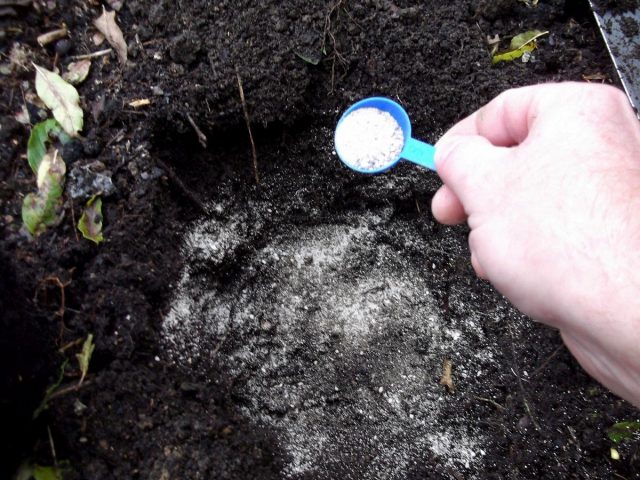 Most often, mycorrhiza is marketed in the form of powder or granules, which are introduced into the soil during planting. Green gardener
Most often, mycorrhiza is marketed in the form of powder or granules, which are introduced into the soil during planting. Green gardener
Planting plants with an open root system
When planting trees, shrubs or strawberry seedlings with bare roots (open root system), it is better to moisten the roots well by dipping them in water, and then dip them in a container with granules just before planting.
Sometimes the so-called "professional mycorrhiza" is on sale, where a special sachet with gel is included in the set. In this case, it is necessary to mix the gel with water until a homogeneous paste is formed (like an emulsion), mix the granules with the gel and dip the roots of the plant. This option ensures maximum contact between roots and mycorrhizal fungi.
In container gardening
When growing plants in containers, mycorrhiza is mixed with the substrate. Micropreparations can be used in any substrates: soil, peat, coconut fiber, mineral wool and hydroponics
When using mycorrhiza in container gardening, it is important to observe several conditions in order to effectively colonize the substrate with fungi:
- the substrate must be constantly moist for the first two weeks from the moment of application of the drug, that is, it must be regularly moistened; after the expiration of this period, watering should be regular, as necessary, but the main thing is to prevent the soil from completely drying out;
- when using mycorrhiza, antifungal drugs should not be added to the substrate;
- for accelerated and successful colonization, it is recommended to feed the mycorrhiza with carbohydrates, which will provide the mushrooms with nutrition and accelerate their growth.
Mycorrhiza for previously planted plants
To add mycorrhiza to plants already growing on your site, you need to purchase a mycorrhiza preparation intended for preparing a working solution. After the powder is diluted in settled water, you need to water it at the root. Usually, for the best effect, the procedure is repeated once every two weeks, or once a month, it is desirable that such waterings be at least five times per season.
Mycorrhiza for seedlings
When using mycorrhiza for seedlings, the micropreparation should be diluted in settled or non-chlorinated water and water the soil abundantly in seedling containers about 2-3 days before sowing seeds. Later, after picking the seedlings, the cut seedlings are watered with a working solution of mycorrhiza. If there are several picks, then the plants are spilled with a solution each time.
Important: for the preparation of emulsions or solutions with mycorrhiza, only filtered or distilled water should be used. Chlorine compounds in tap water inhibit fungal growth
If you cannot use filtered or distilled water, then you need to settle the water from the tap, at least for a day.
Reishi
Treatment at home with a reishi mushroom (aka lacquered tinder fungus, aka lingchi, aka ganoderma, aka "mushroom of immortality") has recently gained more and more popularity against the backdrop of a general enthusiasm for Asian culture and ancient oriental recipes.
Indeed, this mushroom has long been well known as a traditional medicine in the countries of Southeast Asia. In nature, this plant is a saprophyte, i.e. grows and develops on dead and weakened wood, in culture it has been successfully grown for a long time to obtain raw materials with biologically active substances, the most important of which are polysaccharides and triterpenes.
It is with the presence of special polysaccharides in the composition of many mushrooms that modern scientists associate their potential anti-tumor activity, which is being actively studied today.
These substances have a number of properties useful for the human body: analgesic, immunomodulatory, antitumor, antiviral, antibiotic, hepato- and gene-protective, anti-inflammatory, anti-allergic, antioxidant, moreover, they are able to regulate the work of the cardiovascular, respiratory and nervous systems.That is why for hundreds and hundreds of years Reishi has been used in folk oriental medicine as "a remedy for all diseases." Preparations based on it are especially useful for allergy sufferers, heart patients, for diseases of the liver and stomach, neurasthenia and bronchial asthma.
There are enough Reishi preparations on the market today, produced mainly in China. If you have got hold of the fruiting bodies of the mushroom yourself somewhere, you can try to make a general health tea-decoction from them.
In addition to the competent preparation of a homemade fungicide preparation, you need to take care of the correct and timely collection and storage of raw materials in advance. This applies to any of the mushrooms listed in the article!
1 tbsp Pour 0.5 liters of water into the chopped reishi mushroom and cook, stirring occasionally, over low heat for an hour. The resulting water broth is taken in 1 tsp. 3-4 times daily before meals. It is imperative to store the finished broth in the refrigerator.
White mushroom
Everyone's favorite porcini mushroom, too, it turns out, can be not only a delicacy, but also a medicine.
It contains substances with an antioxidant effect, with an immunomodulatory effect, with toning the cardiovascular system and antitumor properties, as well as polysaccharides, lecithin, important proteins and amino acids. And also - substances that inhibit the growth of some pathogenic intestinal bacteria and lower the viscosity of the blood.
An interesting fact - once even frostbite of the skin was treated with extracts from boletus. As modern medicine shows, it really made sense due to the presence of ergothioneine, an amino acid responsible for regenerating and wound healing properties. The human body cannot synthesize this amino acid on its own, so it must be obtained from the diet, and edible cultivated mushrooms (including porcini) contain at least 10 times more ergothioneine than any other food.
To prepare a revitalizing gastrointestinal tract tincture of porcini mushroom, its crushed caps are poured into a glass jar and poured with vodka. After 2-3 weeks of infusion in a dark cool place, the mixture is filtered - it is ready for use. Take a tincture of 1 tsp. after lunch and evening meals.
Candida
The most common fungus, it does not infect a healthy person. At risk are people with
weakened immunity: children, the elderly and people with real causes of immunodeficiency - AIDS patients taking immunosuppressive drugs. You need to be very careful, watch the oral cavity, with your eyes, the spread of the fungus starts from there!
Candida is present on the skin, mucous membranes, when activated, it causes infectious diseases:
- Candidiasis
- Thrush in the mouth
Both diseases are treated with antifungal drugs (eg, fluconazole).
But there are also more invasive forms of manifestation: specific thrombophlebitis; candidiasis of the liver, which causes - fever, chills and even heart failure, depending on where the infection is spreading.
Raincoat
Although in our latitudes the white balls of raincoats in the forest are mainly looking for by children to step on a mature mushroom, "burst" it and admire the flying out cloud of spores, in Europe raincoats are considered a real delicacy and are actively used in cooking. Why not - the mushroom tastes very delicate, contains much more protein than the same mushrooms (by the way, its "relatives"), and it also contains very valuable substances. Moreover, they are valuable not only for gourmets, but also for people suffering from certain ailments.
The fruit bodies of the raincoat contain many times already mentioned the most useful polysaccharides with a cytostatic effect, a complex of vitamins, and also substances that have the properties of natural antibiotics and are capable of removing radionuclides, toxins and heavy metals from the human body.The use of inside preparations of a raincoat is used in anticancer therapy, for digestive disorders, venous stasis, anemia.
Interestingly, not only the "pulp" of the mushroom has healing properties, but also its spores. So, they are very effective for stopping bleeding, with external ulcers or skin eczema. If you get hurt, just fill the damaged area with raincoat spores before applying the bandage - they will help both heal and numb the wound sooner. For the same purposes, you can use the pulp of a young mushroom.
This mushroom is also used in home cosmetology - products based on it mattify the skin, make it more elastic and elastic, even out the color. For these purposes, simply grind the freshly picked washed mushrooms and apply this mass on your face as a mask for 10-15 minutes. If the skin needs to be treated, an alcoholic lotion can be made from the raincoat - the mushroom is finely cut, filled with a mixture of water and alcohol in equal proportions, infused for 2 weeks.
History
Mushrooms have always been one of the gifts of nature used by humans as food, medicine, sometimes - and especially hallucinogens.
The medicinal use of mushrooms is based on the vast experience of traditional (folk) medicine.
Fungotherapy is a method of treating various human diseases based on the use of medicinal mushrooms and complex preparations from them. Methods for processing mushrooms to obtain fungal preparations are focused not on the isolation of a chemically pure active substance, but on the preservation of the entire complex of active substances in the simplest and closest to natural forms (decoction, infusion, extract, etc.).
This method was born and developed in the Far East (Japan and China). The physician Wu Xing left us a treatise on medicinal mushrooms, where he described the properties of more than 100 species of mushrooms growing in China and Japan.
Answers to common questions
This mold, familiar to everyone, is now the subject of controversy among scientists. People are stubbornly looking for new opportunities and abilities of mold, blaming it for many diseases and endowing it with miraculous medicinal properties. Here are the answers to the most common questions about mold:
What mushrooms are antibiotics obtained from?
Antibiotics are synthesized from molds of the genus Penicillus.
Can mold cause pneumonia and cancer?
Some species of Aspergillus and Penicillum secrete Ochratoxin A, a substance that poses a real threat to human health and life. Ochratoxin A itself cannot provoke cancer or pneumonia, but in combination with other threatening factors, everything is possible.
Is it possible to independently determine the type of mold fungus?
All types of mold cannot be recognized with the naked eye. Some of them are perfectly visualized and can be easily identified, while some species can only be viewed with the help of magnifying devices.
Molds are very diverse. The benefits of these mushrooms for humanity are invaluable. But some species pose a serious danger to humans.
Meitake
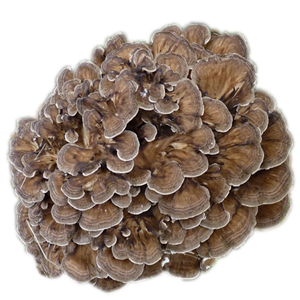 Meitake mushroom is also called "ram mushroom" or "dancing mushroom". This mushroom is incredibly prized in oriental medicine. The medicinal properties of Meitake are currently being actively studied all over the world, but the mushroom itself has been used in medicine for many centuries. The healing properties of this mushroom are rightfully considered some of the most strong.
Meitake mushroom is also called "ram mushroom" or "dancing mushroom". This mushroom is incredibly prized in oriental medicine. The medicinal properties of Meitake are currently being actively studied all over the world, but the mushroom itself has been used in medicine for many centuries. The healing properties of this mushroom are rightfully considered some of the most strong.
The main medicinal power of the mushroom has its constituent beta-glucans polysaccharides. Studies have shown that they have pronounced antiviral and antitumor properties. Meitake preparations have a very good anti-cancer effect. In 1994, studies were carried out in US hospitals that confirmed its high efficiency in cancer patients. Also, the mushroom has proven itself well in getting rid of benign neoplasms, such as fibroids, fibroids, cysts and mastopathy.
Meitake is also called "female mushroom" because it is very popular with women. Gynecologists note the remarkable property of Meitake to improve the well-being of women during the premenstrual and menstrual cycles. The mushroom can reduce pain and improve well-being. Taking Meitake normalizes hormonal levels in women. In addition, taking Meitake normalizes hormonal levels in women in menopause, reduces sweating and hot flashes.
It has a Meitake mushroom and another name. In ancient Japan it was called a "geisha mushroom" because even then, his ability to reduce weight was noticed. In our time, studies were carried out in Tokyo, during which this was fully confirmed. The substances that make up the fungus break down fat cells very well, then removing them from the body with water.
Historical discoveries
It is believed that yeast was used as an industrial microorganism for thousands of years and that the ancient Egyptians used their fermentation to grow bread ..
There are grinding stones, baking chambers and drawings that are believed to be bakeries that date back millennia, and even archaeological excavations have uncovered alleged jars of wine remains.
According to history, these unicellular fungi were first visualized with high quality lenses around 1680 by Anthony van Leeuwenhoek.
However, he thought these globules were particles of grain starch used to make wort (a liquid extract used in brewing), not yeast cells for fermentation.
Later, in 1789, a French chemist named Antoine Lavoisier contributed to the understanding of the basic chemical reactions required to make alcohol from sugarcane.
This was achieved by evaluating the proportion of materials and starting products (ethanol and carbon dioxide) after adding the yeast paste. NeverthelessAt the time, it was believed that the yeast was just there to start the reaction and not be foundational throughout the entire process.
In 1815, also the French chemist Joseph-Louis Gay-Lussac developed methods for keeping grape juice unfermented and discovered that the introduction of an enzyme (containing yeast) was necessary to convert the unfermented wort, demonstrating the importance of yeast for alcoholic fermentation. Then Charles Canyard de la Tour in 1835 used a microscope with more power to prove that yeast is single-celled organisms and reproduces by germination
Then Charles Canyard de la Tour in 1835 used a microscope with more power to prove that yeast is single-celled organisms and reproduces by germination.
By the 1850s, Louis Pasteur had discovered that fermented beverages were the result of yeast converting glucose into ethanol, and defined fermentation as "shortness of breath."
To detect zymase, Eduard Büchner in the late 1800s used cell-free extracts obtained by grinding yeast, collecting enzymes that stimulate or catalyze fermentation. He was awarded the Nobel Prize in 1907 for this research.
Between 1933 and 1961, Oivind Winge, known as the "father of yeast genetics", together with his colleague Otto Laussen, developed methods for micro-manipulating yeast and thus were able to genetically investigate it ..
Since then, many other scientists have conducted innovative research, and several have been awarded the Nobel Prize for significant discoveries, including: Dr. Leland Hartwell (2001); Dr. Roger Kornberg (2006) Drs Elizabeth Blackburn, Carol Grader and Jack Shostak (2009), and more recently Drs. Randy Sheckman, James Rothman and Thomas Sudhof (2013) and Dr. Yoshinori Osumi (2016).
Sanhwan
The Sanhwan mushroom is a species of Tinder fungus. It is a tree fungus that lives on deciduous trees.Sanhwan, harvested from mountain ash, alder and chestnut, is most appreciated. In Russia, this mushroom is known to few people, although in oriental medicine it is highly valued. Sanvkhan will help with both gastrointestinal diseases and has a good general strengthening effect. But the most important are its anti-tumor properties. Sanhwan is very effective during chemotherapy. Scientists at Boston University have conducted a number of studies on the fungus in this regard. The Sanghwan polysaccharide complex has a destructive effect on cancer cells. It suppresses their development and weakens them greatly, which makes chemotherapy more effective. The fungus makes it easier for chemotherapy drugs to enter cancer cells. At the same time, you are the very polysaccharides that protect healthy cells in the body. Studies have shown that taking Sanhwan during chemotherapy multiplies its effect and reduces the negative effects on the body.

